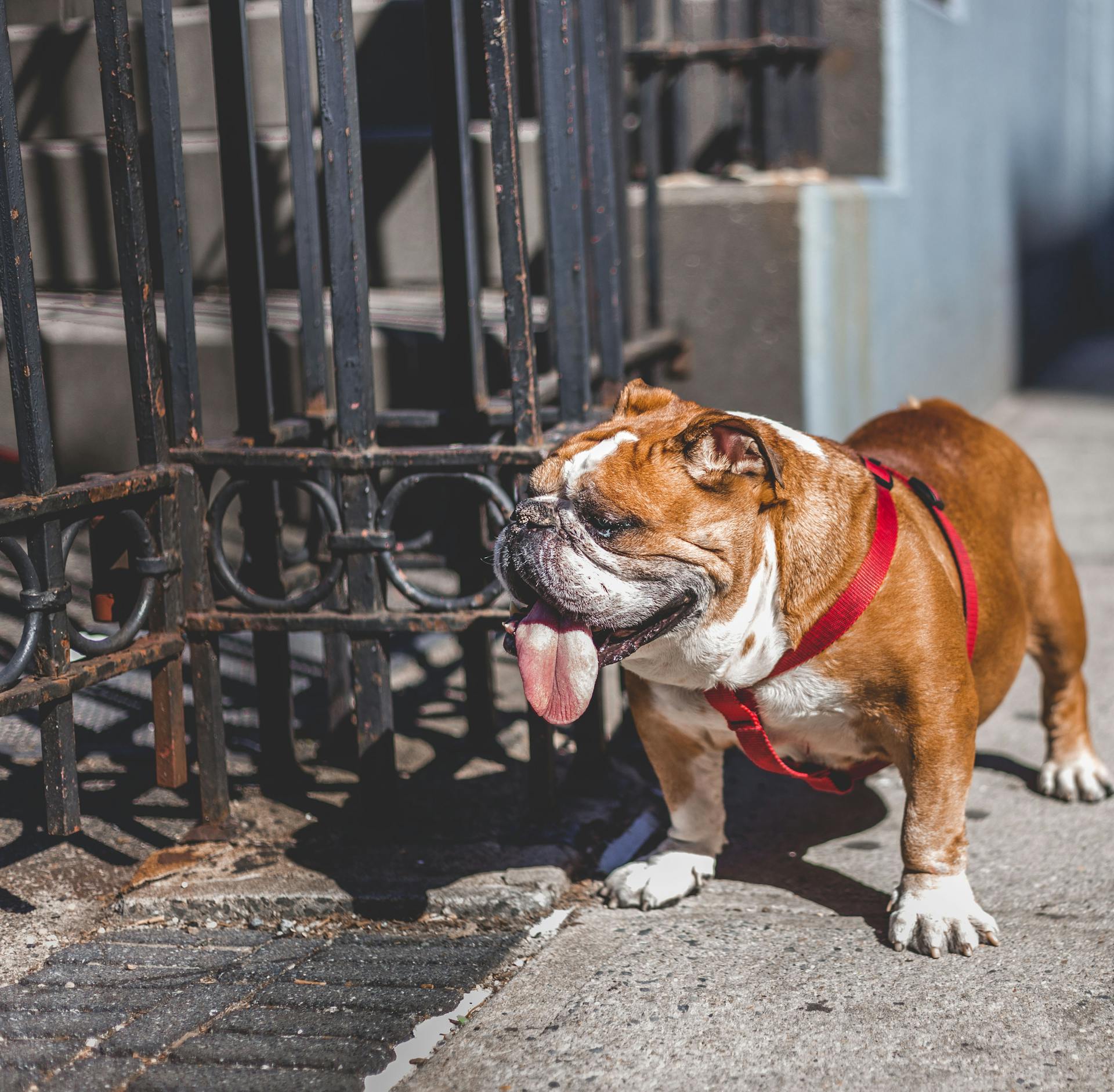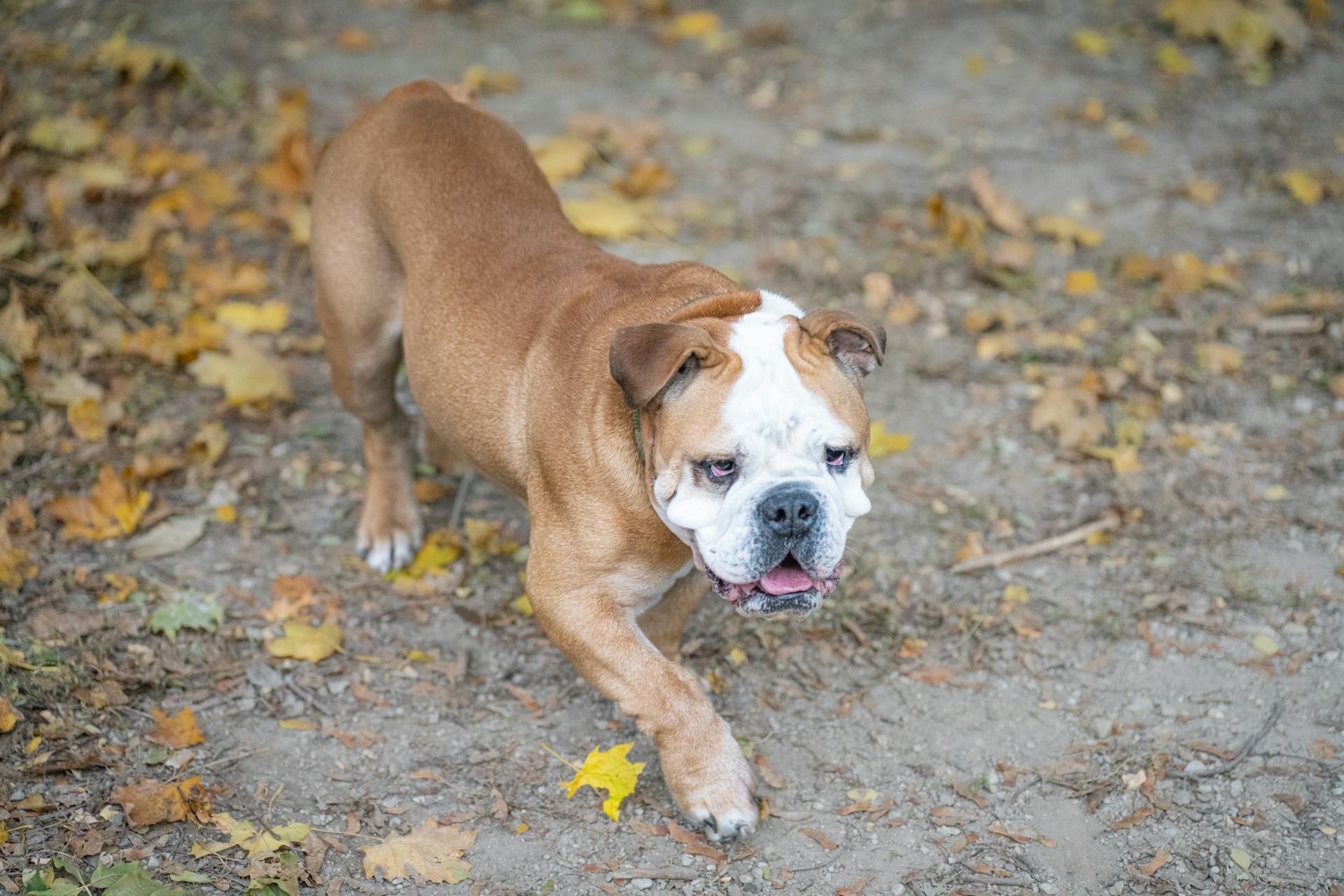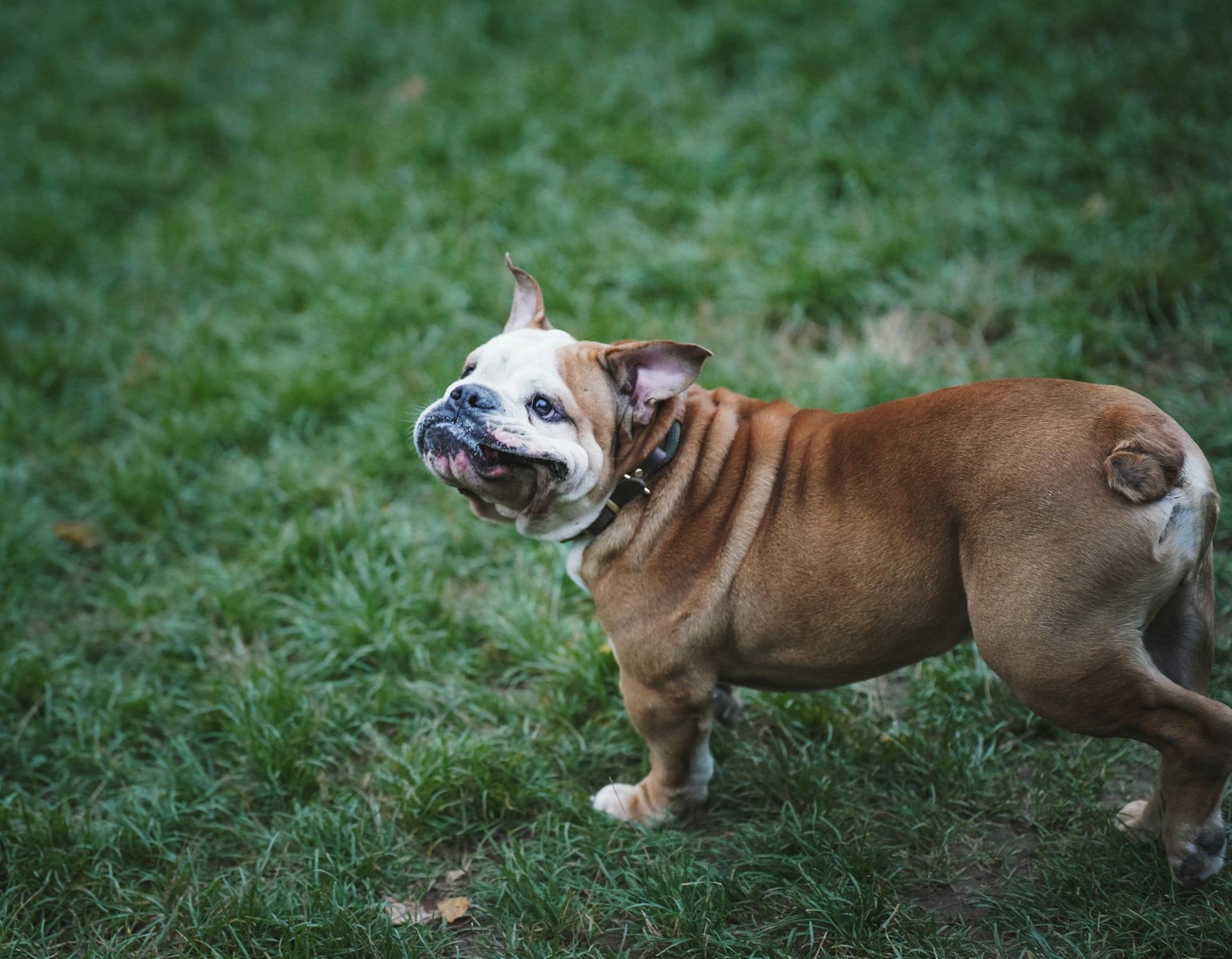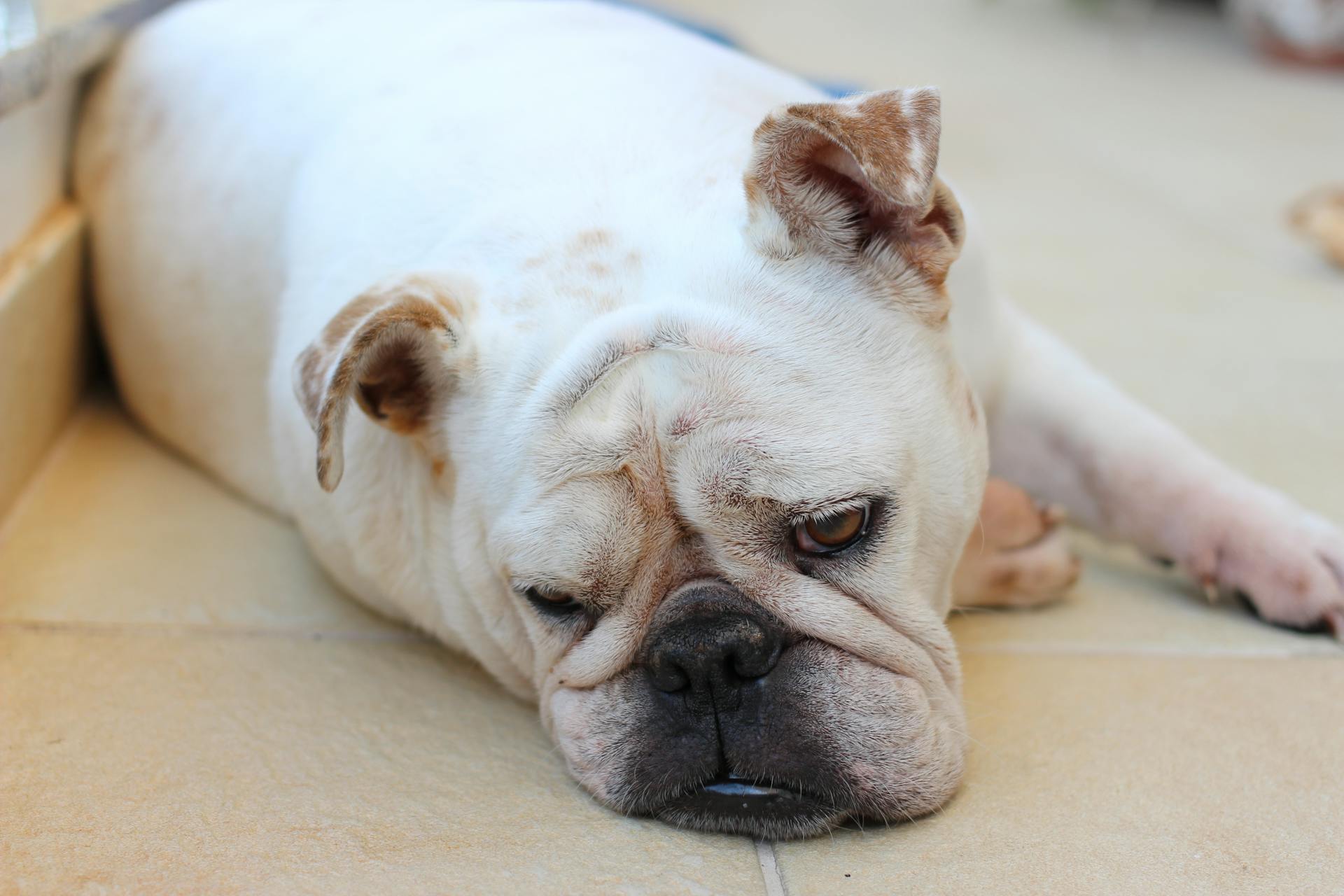
English Bulldogs can weigh anywhere from 40 to 55 pounds, with a height range of 10 to 14 inches, making them a sturdy and compact breed.
Their weight is influenced by their brachycephalic skull structure, which can lead to breathing difficulties and other health issues.
Proper management of their weight is crucial to prevent these health risks, such as joint problems, skin infections, and respiratory problems.
Regular exercise, a balanced diet, and regular veterinary check-ups can help prevent or manage these health issues.
Physical Characteristics
English bulldogs are a sturdy breed with a distinctive physical appearance. They typically weigh between 40-55 pounds.
Their compact, muscular bodies are a result of centuries of selective breeding for a specific look. English bulldogs have a broad, flat head and a short, curved muzzle.
Their coats are short and smooth, requiring minimal grooming. They come in a variety of colors, including fawn, brindle, and white.
Their short, stout legs and compact body make them well-suited for a sedentary lifestyle. English bulldogs can be prone to obesity if they don't get enough exercise.
Their broad chests and well-sprung ribs are a hallmark of the breed. This physical characteristic allows them to take in plenty of oxygen, which is essential for their relatively short, easy breathing.
For more insights, see: Short Bulldog Breeds
Care and Nutrition
English bulldogs are prone to weight gain, so it's essential to monitor their calorie intake closely. Work with your vet to determine the right amount of food for your dog.
Feeding table scraps or extra treats can lead to weight gain, so it's best to avoid them altogether. Treats should make up no more than 10% of your dog's daily caloric intake.
Bulldogs can be possessive of their food, so it's crucial to address this behavior early on. Talk to your vet or a professional dog trainer about how to reduce or prevent resource guarding.
A daily walk around the neighborhood, especially during cooler hours, can help wear out your bulldog and maintain a healthy weight. A quick play session can also be beneficial.
Bulldogs don't need frequent brushing, but their wrinkles require regular cleaning to prevent irritation and infection. Keep their face clean and dry to prevent any issues.
Intriguing read: English Bulldog Vet
Trimming their nails once a month can help prevent clicking on the floor, which can be annoying. Brushing their teeth weekly or daily can prevent future vet visits.
Bulldogs are better off with two measured meals a day rather than leaving the bowl out all the time. This can help prevent weight gain and ensure they're eating the right amount of food.
Health and Conditions
English bulldogs are prone to breathing problems due to brachycephalic syndrome, which can lead to stenotic nares and an elongated soft palate. This can cause them to struggle with respiratory difficulties.
Some bulldogs may develop skin infections like pyoderma, a bacterial skin infection, or skin fold dermatitis. Regular grooming sessions can help prevent these issues.
Eye disorders are common in bulldogs, including keratoconjunctivitis sicca (dry eye), entropion, ectropion, cherry eye, and distichiasis. It's essential to monitor your bulldog's eye health closely.
Bulldogs are also at risk for ventricular septal defect, a birth defect that results in a hole in the wall separating the lower heart chambers. This can lead to serious health issues.
To minimize the risk of joint problems, it's crucial to monitor your bulldog's weight and prevent obesity. A balanced diet and regular exercise can help maintain a healthy weight.
Here are some common health issues that can affect English bulldogs:
Regular veterinary check-ups and proper care can help prevent or manage these health issues.
Living with English Bulldogs
Living with English Bulldogs can be a wonderful experience, especially if you're willing to adapt to their unique needs. They thrive best in temperate climates, where temperatures are mild and not too hot or cold.
English Bulldogs are low-endurance dogs, which means they're not built for long, strenuous activities. They do enjoy daily outings and walks, but it's essential to keep them short and sweet. They might enjoy chasing a ball or wrestling with a toy, but running is difficult for them.
As a Bulldog owner, you'll need to be mindful of their breathing difficulties, which can make them snort, wheeze, and snore. They also tend to drool and love to chew, so be sure to have plenty of durable toys and ropes on hand.
Exercise
English Bulldogs aren't built for long-distance running, so it's best to keep their exercise sessions short and sweet. They enjoy daily outings and walks, but running is difficult for them.
Moderate exercise is a great way to keep your dog fit and healthy, but be mindful of their breathing difficulties due to their short muzzles. They should avoid strenuous exercise in hot weather, as this can lead to heatstroke.
Bulldogs have trouble with stairs, so it's best to avoid taking them on long stair climbs. They should also never be allowed in water that is more than elbow deep without supervision and a life jacket.
Limit your bulldog's walks to short outings in the early morning and evening to avoid the heat of the day. Provide them with access to cool, air-conditioned space so that they can breathe comfortably regardless of the heat outside.
Daily walks of no more than 20 to 30 minutes are a great way to keep your bulldog happy and healthy. Some bulldogs even enjoy more vigorous activities like off-leash fetch or romping at the dog park.
A unique perspective: English Bulldog Exercise
Living with Them
Living with English Bulldogs requires some special consideration. They're low-endurance dogs, which means they're perfect for indoor living and don't need a yard.
Their short snouts make them sensitive to extreme temperatures, so they thrive best in temperate climates. They can't tolerate high heat, which can cause them to overheat and have breathing difficulties.
English Bulldogs also don't do well in cold weather, so you'll need to make sure they're comfortable and warm at home. They're not built for active lifestyles, so if you're single, retired, or have a young family, they might be a great choice.
Bulldogs aren't known to be barkers, but they do make lots of other noises, especially when they're sleeping. You can expect to hear snorting, wheezing, and snoring from your Bulldog.
Drooling is also a common trait in English Bulldogs, so be prepared for a bit of slobbering. To keep them happy and healthy, make sure to provide plenty of durable toys and ropes for them to chew on.
Temperament
English Bulldogs are delightfully sweet if socialized early, but can become territorial and unmanageable with other dogs and animals if not.
Their laid-back attitude is developed through plenty of positive interactions with kids, people, and animals from an early age. This helps them become generally compliant with people and less defensive with strangers.
They're rarely aggressive and almost dopey, often not understanding what you're saying, but they're always kind and earnest in their ways.
Appearance and Weight
English Bulldogs are a distinctive breed with a unique physical appearance. Their small, thin ears are located at the back of the head, and they have deep folds of loose skin that start on the forehead and extend down to the jowl.
They have a broad, black nose, hanging upper lips, and a strongly undershot lower jaw. Their anatomy is classified as brachycephalic, with eyes set wide above a short muzzle.
Their large heads and broad shoulders make them a sturdy-looking dog. Given their short, sturdy, and wide-set legs, they tend to move quite slow.
The average English Bulldog weight is between 40 and 50 pounds, and they stand between 12 and 16 inches tall at the shoulders.
If this caught your attention, see: Ruby Short Hair Cavalier King Charles Spaniel
Characteristics

The English Bulldog's temperament is truly one-of-a-kind. They have an equable and kind disposition, which makes them a wonderful companion.
One of the most striking things about Bulldogs is their characteristic demeanor, which is one of peace and dignity. This is evident in their expression and behavior.
Bulldogs are also known for their resolute and courageous nature, which is a testament to their strong character.
Despite their tough exterior, Bulldogs are actually amiable and sweet-natured companions. They are great family dogs and get along with adults and kids alike.
In fact, Bulldogs are one of the most popular breeds in both England and North America. They usually coexist peacefully with other pets, although some dogs of the same sex might not get along.
Here's a quick rundown of the Bulldog's temperament:
Appearance
English Bulldogs have a distinctive look that's hard to miss. Their small, thin ears are located at the back of the head, and they have deep folds of loose skin that start on the forehead and extend down to the jowl.

Their anatomy is classified as brachycephalic, with eyes set wide above a short muzzle that features a broad, black nose, hanging upper lips, and a strongly undershot lower jaw.
English Bulldogs are characterized by their large heads and broad shoulders, which make them look quite sturdy. They have short, sturdy, and wide-set legs, which make them move quite slowly.
The average English Bulldog weight is between 40 and 50 pounds. They stand between 12 and 16 inches tall at the shoulders.
Their short, smooth coat comes in a variety of colors, including white, fawn, red, and brindle. They often have white markings, piebald markings, and black masks.
English Bulldogs have a pear-shaped outline when viewed from above, with a slight fall off behind the shoulders to the beginning of the back. Their topline is a distinguishing characteristic of this breed.
Their body is moderately short and well knit, with stout limbs, well-muscled, and in hard condition. The brisket and body are very capacious, and the chest is very deep and well let down between the front legs.
The weight range for mature males is from 50 to 55 pounds, while for mature females it's from 45 to 50 pounds.
Broaden your view: How Much Food Should a 50 Lb English Bulldog Eat
History and Diet
The Olde English Bulldogge is a breed that thrives on high-quality dog food rich in protein, fatty acids, and probiotics.
To meet their high energy requirements, a high-protein, high-calorie dog food is a great choice. This is especially important for active breeds like the Olde English Bulldogge.
Consulting with your vet is always the best idea when it comes to figuring out the best diet for your Olde English Bulldogge, as they can provide specific recommendations for their breed.
Intriguing read: Best Food for Olde English Bulldog
History of
In 13th-century England, bulldogs were used as fighting dogs in a gruesome sport called bullbaiting.
Bulldogs looked and acted very different back then, being much fiercer than the gentle pets we know today.
After blood sports like bullbaiting were outlawed, bulldogs were out of a job, but some devoted owners worked to save the breed.
With some careful breeding, the bulldog was transformed into the slow, ambling, sweet, and loving pet we know and love today.
Food & Diet

Bulldogs love to eat, and it's essential to work with your veterinarian to determine the right daily food intake for your furry friend. This will help prevent overeating and joint stress.
Leaving food out all the time can lead to overeating, so it's best to feed measured meals at scheduled times.
Featured Images: pexels.com


